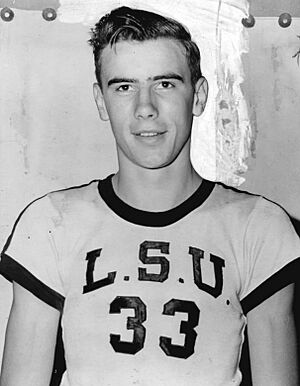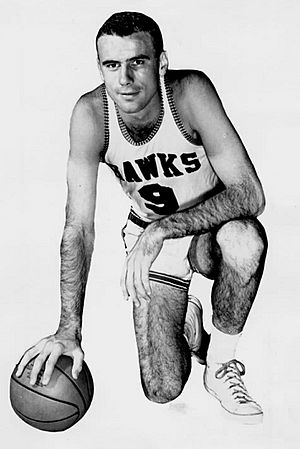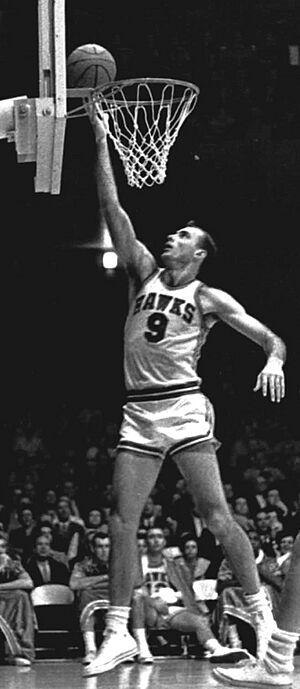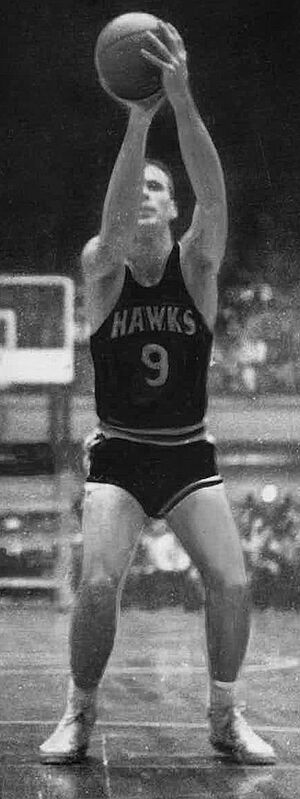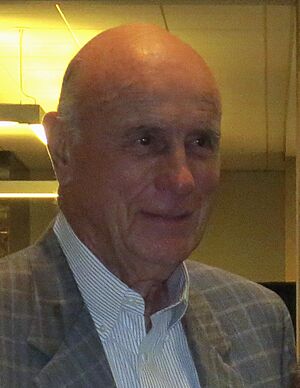Bob Pettit facts for kids
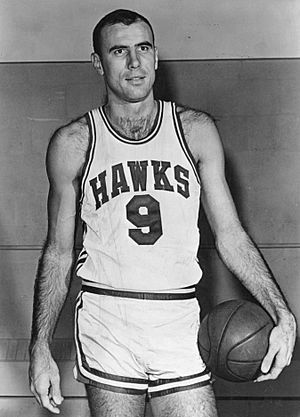
Pettit with the St. Louis Hawks in 1961
|
|
| Personal information | |
|---|---|
| Born | December 12, 1932 Baton Rouge, Louisiana, U.S. |
| High school | Baton Rouge (Baton Rouge, Louisiana) |
| Listed height | 6 ft 9 in (2.06 m) |
| Listed weight | 205 lb (93 kg) |
| Career information | |
| College | LSU (1951–1954) |
| NBA Draft | 1954 / Round: 1 / Pick: 2nd overall |
| Selected by the Milwaukee Hawks | |
| Pro career | 1954–1965 |
| Career history | |
| 1954–1965 | Milwaukee / St. Louis Hawks |
| Career highlights and awards | |
|
|
| Career NBA statistics | |
| Points | 20,880 (26.4 ppg) |
| Rebounds | 12,849 (16.2 rpg) |
| Assists | 2,369 (3.0 apg) |
Robert E. Lee Pettit Jr., born on December 12, 1932, is a famous American basketball player. He played for 11 seasons in the NBA. He played his whole career with the Milwaukee and St. Louis Hawks teams from 1954 to 1965. In 1956, he was the very first player to win the NBA's MVP Award. He won it again in 1959. He also won the NBA All-Star Game MVP award four times.
As of July 2025, Bob Pettit is still the only regular season MVP in the history of the Hawks team. He holds the Hawks' record for most career rebounds (12,849). He also has the most rebounds per game with 16.2 in the team's history.
Bob Pettit was the first NBA player to score more than 20,000 points in his career. He was added to the Naismith Memorial Basketball Hall of Fame in 1970. He is one of only four players who were named to all four NBA anniversary teams. These teams celebrate the best players from different eras. Many people think he is one of the greatest power forwards of all time.
Contents
Early Life and High School Basketball
Robert E. Lee Pettit Jr. was born in Baton Rouge, Louisiana. His basketball journey started slowly. When he was a freshman and sophomore at Baton Rouge High School, he was cut from the varsity team.
He played basketball in a church league during his sophomore year. He also grew five inches in less than a year! His father encouraged him to practice a lot. This hard work paid off. Pettit became a starter and made the All-City team as a junior. As a senior, he was 6 feet 7 inches tall. He led Baton Rouge High to win its first state championship in over 20 years.
College Basketball Career
After high school, Pettit received many scholarship offers. He chose to play at Louisiana State University (LSU). He was a top player in the Southeastern Conference (SEC) three times. He was also named an All-American twice for the LSU men's basketball team. Back then, freshmen could not play on the main varsity team.
Pettit's First Year at LSU
Pettit started playing for LSU in 1952. He led the SEC in scoring for three years in a row. In his first year, he averaged 25.5 points per game. He was the third-highest scorer in the nation. He also grabbed 13.1 rebounds per game. His team finished second in the league with a 17–7 record. He was chosen for the All-SEC team.
Junior Year Success
During his junior year, Pettit helped the Tigers have a great season. They won 23 games and lost only one. They won every game against SEC opponents. This gave LSU its second SEC Title. It was also the school's first time reaching the NCAA Final Four. He averaged 24.9 points and 13.9 rebounds per game that season. He was honored by being selected for both the All-SEC and All-American teams.
Senior Year and Records
In his senior year, Pettit averaged 31.4 points and 17.3 rebounds per game. He led LSU to another SEC Championship. He also earned All-SEC and All-American honors again. He set a new SEC scoring record with 60 points in one game. This record was later broken by Pete Maravich. Pettit was only the second player in major college basketball history to average more than 30 points a game.
In 1954, LSU retired his jersey number, 50. He was the first LSU athlete in any sport to receive this special honor. In 1999, he was named a "Living Legend" for LSU at the SEC Basketball Tournament. He is also a member of the LSU Hall of Fame. A street in Baton Rouge, Louisiana, called Bob Pettit Boulevard, is named after him.
Professional Basketball Career
Playing for the Milwaukee and St. Louis Hawks (1954–1965)
In 1954, the Milwaukee Hawks picked Bob Pettit second in the NBA draft. He was a bit unsure about joining the team at first. But his cousin, Frank Brian, who was also an NBA player, convinced him. Pettit signed a contract for $11,000. This was a very high amount for an NBA rookie back then.
Pettit played center in college. But his coach, Red Holzman, moved him to forward. This was because Pettit was still getting used to the NBA's strong players. He said it was hard to adjust because he had never played forward before. Even with these challenges, Pettit won the NBA Rookie of the Year Award in 1955. He averaged 20.4 points and 13.8 rebounds per game. The team finished last in their division that year. After the season, the Hawks team moved to St. Louis.
In their first year in St. Louis (1955–56), Pettit helped the Hawks win 33 games. In his second season, Pettit changed his playing style. He focused on getting to the free-throw line often. This gave his team easy points and caused opponents to get into foul trouble. He was also great at getting offensive rebounds. He once said that offensive rebounds were worth "eight to 12 points a night" for him. He also got many points from free throws.
Pettit won his first scoring title that year, averaging 25.7 points. He also led the league in rebounding with 16.2 rebounds per game. He was named MVP of the 1956 NBA All-Star Game. He scored 20 points, had 24 rebounds, and 7 assists in that game. He would win the All-Star Game MVP award three more times (in 1958, 1959, and 1962). He also won his first NBA regular season MVP award in 1956. He won it again in 1959.
Before the 1956–57 season, the Hawks made some big trades. They got Ed Macauley and Cliff Hagan from the Boston Celtics. They also added Slater Martin and Alex Hannum. Hannum became the team's coach during the season. The Hawks had a 34–38 record that year. But they made it to the NBA Finals!
In Game 1 of the 1957 NBA Finals, Pettit scored 37 points. The Hawks surprised the Bill Russell-led Boston Celtics in double overtime. Pettit helped his team win Game 3 with a late basket. In Game 7, his two free throws with six seconds left forced overtime. Pettit had 39 points and 19 rebounds in that game. But it was not enough, and the Hawks lost in double overtime. Pettit averaged 29.8 points and 16.8 rebounds per game during the 1957 playoffs.
The Hawks won a team-record 41 games in 1958. They met the Celtics again in the 1958 NBA Finals. Pettit led the Hawks to an NBA Championship! He scored a playoff-record 50 points in Game 6. This win clinched the series for the Hawks. Pettit's 50 points was the most ever in a Finals close-out game for many years. It was matched by Giannis Antetokounmpo in 2021.
For the 1958 season, Pettit averaged 24.6 points and 17.4 rebounds per game. He also earned All-Star Game MVP honors. He had 28 points and 26 rebounds in that game. St. Louis finished at the top of the Western Division for the next three seasons. Pettit's scoring average of 29.2 points per game in the 1958–59 season was an NBA record at the time. He was also named the Sporting News NBA MVP.
In the 1960–61 season, Pettit averaged 27.9 points per game. He also grabbed an amazing 20.3 rebounds per game. This made him one of only five players ever to average more than 20 rebounds per game. He, Wilt Chamberlain, and Jerry Lucas are the only three players to average more than 20 points and 20 rebounds in an NBA season. On February 18, 1961, Pettit scored a career-high 57 points. He also had 28 rebounds in a win against the Detroit Pistons.
In the next season, he scored a career-best 31.1 points per game. Pettit ended his career in 1965. He was still playing at a very high level. He was the first NBA player to score more than 20,000 points in his career. He finished with 20,880 points, averaging 26.4 points per game. Almost 30 percent of his points came from free throws. When he retired, his 12,849 rebounds were the second-most in league history. His career average of 16.2 rebounds per game is still the third-highest ever. Only Wilt Chamberlain and Bill Russell had more.
Pettit was an NBA All-Star in all 11 of his seasons. He was named to the All-NBA First Team ten times. He was also named to the All-NBA Second Team once. Pettit still holds the top two NBA All-Star Game rebounding records. He had 26 rebounds in 1958 and 27 in 1962. He also has the second-highest All-Star Game points per game average with 20.4.
Pettit averaged at least 20 points and 12 rebounds per game in every one of his 11 NBA seasons. No other retired player in NBA history, except for Pettit and Alex Groza, has averaged more than 20 points per game in every season they played.
In 1970, Bob Pettit was inducted into the Naismith Memorial Basketball Hall of Fame. He is one of four players who were named to all four NBA anniversary teams. These teams celebrate the best players from the NBA's 25th, 35th, 50th, and 75th anniversaries. The other players are Bob Cousy, George Mikan, and Bill Russell.
Life After Basketball
After his basketball career, Bob Pettit worked in banking for 23 years. In 1988, he started working in financial consulting. He helped people with their money. In 2006, he retired from a company he helped start, Equitas Capital Investors.
Bob Pettit was married to his wife Carole, who passed away in 2010. They had three children and 10 grandchildren.
NBA Career Statistics
| Legend | |||||
|---|---|---|---|---|---|
| GP | Games played | GS | Games started | MPG | Minutes per game |
| FG% | Field goal percentage | 3P% | 3-point field goal percentage | FT% | Free throw percentage |
| RPG | Rebounds per game | APG | Assists per game | SPG | Steals per game |
| BPG | Blocks per game | PPG | Points per game | Bold | Career high |
Regular Season Stats
| Year | Team | GP | MPG | FG% | FT% | RPG | APG | PPG |
|---|---|---|---|---|---|---|---|---|
| 1954–55 | Milwaukee | 72 | 36.9 | .407 | .751 | 13.8 | 3.2 | 20.4 |
| 1955–56 | St. Louis | 72 | 38.8 | .429 | .736 | 16.2 | 2.6 | 25.7* |
| 1956–57 | St. Louis | 71 | 35.1 | .415 | .773 | 14.6 | 1.9 | 24.7 |
| 1957–58† | St. Louis | 70 | 36.1 | .410 | .749 | 17.4 | 2.2 | 24.6 |
| 1958–59 | St. Louis | 72* | 39.9 | .438 | .759 | 16.4 | 3.1 | 29.2* |
| 1959–60 | St. Louis | 72 | 40.2 | .438 | .753 | 17.0 | 3.6 | 26.1 |
| 1960–61 | St. Louis | 76 | 39.8 | .447 | .724 | 20.3 | 3.4 | 27.9 |
| 1961–62 | St. Louis | 78 | 42.1 | .450 | .771 | 18.7 | 3.7 | 31.1 |
| 1962–63 | St. Louis | 79 | 39.1 | .446 | .774 | 15.1 | 3.1 | 28.4 |
| 1963–64 | St. Louis | 80 | 41.2 | .463 | .789 | 15.3 | 3.2 | 27.4 |
| 1964–65 | St. Louis | 50 | 35.1 | .429 | .820 | 12.4 | 2.6 | 22.5 |
| Career | 792 | 38.8 | .436 | .761 | 16.2 | 3.0 | 26.4 | |
| All-Star | 11 | 32.7 | .420 | .775 | 16.1 | 2.0 | 20.3 | |
Playoff Stats
| Year | Team | GP | MPG | FG% | FT% | RPG | APG | PPG |
|---|---|---|---|---|---|---|---|---|
| 1956 | St. Louis | 8 | 34.3 | .367 | .843 | 10.5 | 2.3 | 19.1 |
| 1957 | St. Louis | 10 | 43.0 | .414 | .767 | 16.8 | 2.5 | 29.8 |
| 1958† | St. Louis | 11 | 39.1 | .391 | .729 | 16.5 | 1.8 | 24.2 |
| 1959 | St. Louis | 6 | 42.8 | .423 | .785 | 12.5 | 2.3 | 27.8 |
| 1960 | St. Louis | 14 | 41.1 | .442 | .754 | 15.8 | 3.7 | 26.1 |
| 1961 | St. Louis | 12 | 43.8 | .412 | .757 | 17.6 | 3.2 | 28.6 |
| 1963 | St. Louis | 11 | 42.1 | .459 | .778 | 15.1 | 3.0 | 31.8 |
| 1964 | St. Louis | 12 | 41.2 | .412 | .835 | 14.5 | 2.8 | 21.0 |
| 1965 | St. Louis | 4 | 23.8 | .366 | .800 | 6.0 | 2.0 | 11.5 |
| Career | 88 | 40.3 | .418 | .774 | 14.8 | 2.7 | 25.5 | |
See also
 In Spanish: Bob Pettit para niños
In Spanish: Bob Pettit para niños
- List of NBA career scoring leaders
- List of NBA franchise career scoring leaders
- List of NBA career rebounding leaders
- List of NBA annual rebounding leaders
- List of NBA single-game playoff scoring leaders


